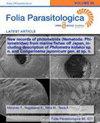Intestinal parasites of buffalo calves from Romania: molecular characterisation of Cryptosporidium spp. and Giardia duodenalis, and the first report of Eimeria bareillyi.
IF 1.5
4区 医学
Q3 PARASITOLOGY
引用次数: 3
Abstract
Buffaloes represent an important economic resource for several regions of the world including Romania. In the present study, we examined 104 faecal samples collected from 38 buffalo calves (2-11 weeks old) from household rearing systems in Romania for gastrointestinal parasites. All samples were tested using the saturated salt flotation, McMaster and modified Ziehl-Nielsen staining methods. PCR coupled with sequencing isolates were used to identify assemblages of Giardia lamblia (Kunstler, 1882) and species of Cryptosporidium Tyzzer, 1907. Overall, 33 out of 38 examined buffalo calves were infected with different gastrointestinal parasites: 16 had single infections and 17 had mixed infections with two or three parasites. Species of Eimeria Schneider, 1875 (32/38; 84%) were the most prevalent parasites; eight species were identified according to the oocyst morphology, including the pathogenic E. bareillyi (Gill, Chhabra et Lall, 1963) which was detected for the first time in buffaloes from Romania. The nematodes Toxocara vitulorum (Goeze, 1782) (11/38; 37%) and Strongyloides papillosus (Wedl, 1856) (6/38; 16%) were also detected. Cryptosporidium spp. were found in four (11%) buffalo calves; two of them were molecularly identified as C. ryanae Fayer, Santin et Trout, 2008, and another one clustered in the same clade with C. ryanae, C. bovis Fayer, Santin et Xiao, 2005, and C. xiaoi Fayer et Santin, 2009. Giardia duodenalis assemblage E was also molecularly detected in a single (2.6%) buffalo calf. The presence of other buffaloes in the same barn was identified as a risk factor for infection with T. vitulorum. Our results indicate extensive parasitic infections in buffalo calves from northwestern Romania and underline the necessity of prophylactic treatments for T. vitulorum and E. bareillyi.罗马尼亚水牛幼崽的肠道寄生虫:隐孢子虫属和十二指肠贾第虫的分子特征,以及巴氏艾美耳球虫的首次报道。
水牛是包括罗马尼亚在内的世界多个地区的重要经济资源。在本研究中,我们检查了从罗马尼亚家庭饲养系统采集的38头水牛幼崽(2-11周大)的104份粪便样本中的胃肠道寄生虫。使用饱和盐浮选法、麦克马斯特法和改良的Ziehl-Nielsen染色法对所有样品进行测试。PCR与测序分离株相结合,用于鉴定兰氏贾第鞭毛虫(Kunstler,1882)和Tyzzer隐孢子虫(Cryptosporidium Tyzzer,1907)的组合。总的来说,38头接受检查的水牛幼崽中有33头感染了不同的胃肠道寄生虫:16头感染了单一感染,17头感染了两到三种寄生虫。Eimeria Schneider,1875种(32/38;84%)是最常见的寄生虫;根据卵囊形态鉴定出8种,其中包括首次在罗马尼亚水牛中检测到的致病性E.bareilli(Gill,Chhabra et Lall,1963)。还检测到了线虫Toxocara vitulorum(Goeze,1782)(11/38;37%)和Strongyloides papillosus(Wedl,1856)(6/38;16%)。在4头(11%)水牛幼崽身上发现隐孢子虫属;其中两个被分子鉴定为C.ryanae-Fayer,Santin et Trout,2008,另一个与C.ryanae、C.bovis-Fayer、Santin et Xiao,2005和C.xiaoi-Fayer et Santin,2009聚集在同一支中。十二指肠贾第鞭毛虫组合E也在单个(2.6%)水牛中被分子检测到。在同一个畜棚中存在其他水牛被确定为感染毛滴虫的风险因素。我们的研究结果表明,罗马尼亚西北部水牛幼崽存在广泛的寄生虫感染,并强调了预防性治疗黄颡菌和巴氏乳杆菌的必要性。
本文章由计算机程序翻译,如有差异,请以英文原文为准。
求助全文
约1分钟内获得全文
求助全文
来源期刊

Folia Parasitologica
医学-寄生虫学
CiteScore
2.70
自引率
0.00%
发文量
25
审稿时长
>12 weeks
期刊介绍:
FOLIA PARASITOLOGICA, issued in online versions, is an international journal that covers the whole field of general, systematic, ecological and experimental parasitology. It publishes original research papers, research notes and review articles. Contributions from all branches of animal parasitology, such as morphology, taxonomy, biology, biochemistry, physiology, immunology, molecular biology and evolution of parasites, and host-parasite relationships, are eligible. Novelty and importance in the international (not local or regional) context are required. New geographical records of parasites, records of new hosts, regional parasite and/or host surveys (if they constitute the principal substance of manuscript), local/regional prevalence surveys of diseases, local/regional studies on epidemiology of well known diseases and of parasite impact on human/animal health, case reports, routine clinical studies and testing of established diagnostic or treatment procedures, will not be considered. One species description will also not be considered unless they include more general information, such as new diagnostic characters, host-parasite associations, phylogenetic implications, etc. Manuscripts found suitable on submission will be reviewed by at least two reviewers.
 求助内容:
求助内容: 应助结果提醒方式:
应助结果提醒方式:


